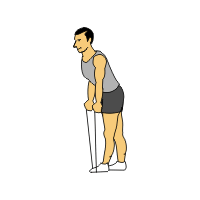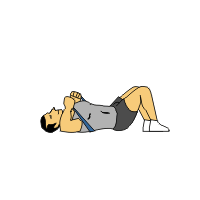Resistance Band Exercises
Resistance band exercises are widely used by a variety of health and fitness practitioners - both for general strength and conditioning and rehabilitation or injury prevention.
Resistance band exercises are ideal for home exercise programs and can easily be incorporated into a circuit training format helping to condition cardiovascular system as well as strengthening specific muscle groups. Because resistance tubing is so compact and lightweight, it can be used while away from home.
Resistance tubing is extremely adaptable and a large number of resistance band exercises can be developed with very little additional equipment. Smaller muscle groups that are hard to train with more traditional free weight exercises can be targeted with resistance tubing. This makes it particularly appealing to athletic conditioning.
Sports-specific conditioning involves training movements rather than individual muscle groups. The versatility of resistance band exercises allows the athlete to mirror very closely the movement patterns in their sport with varying degrees of resistance. Perhaps even more important is the role they can play in injury prevention and rehabilitation...
Resistance Band Exercises for Injury Prevention & Rehabilitation
Few studies have examined the effects of resistance band exercises on strengthening a specific muscle group. As a result no definite guidelines exist as to the number of sets, repetitions and amount of resistance that should be used. However, many health and fitness practitioners use resistance tubing routinely to prevent and rehabilitate overuse injuries by strengthening often smaller, neglected muscle groups.
For example, athletic movements such as a baseball pitch can place considerable demand on the posterior rotator cuff muscles (external rotators, supraspinatus, infraspinatus, teres minor). These muscles undergo eccentric contraction during the declaration phase of the pitch (1,2), which places considerable strain on the shoulder (3,4). However, the same muscles may not be effectively worked with traditional isotonic exercises (5). If larger muscle groups, such as the deltoids, become stronger and are able to cope with and apply greater force, this may further compromise the rotator cuff muscles.
A program of resistance band exercises to compliment regular strength training may be able to improve the strength of more isolated muscle groups such as the rotator cuff (5,6). Additionally, training these otherwise neglected muscles may even improve performance (6).
Of course resistance band exercises can be used for more than simply strengthening more isolated muscle groups. The exercises below work the major muscle groups are only a small sample of the many hundreds of variations that have been devised.
Athletes may want to incorporate them into an off season training program when recovery and regeneration is the most important goal.
Resistance bands are available in a range of colors that relate to their stiffness or resistance. Color-coding varies between the brands but it typically as follows:
Yellow (thin)
Red (medium)
Green (heavy)
Blue (extra heavy)
Black (special heavy)
Silver (super heavy)
Red (medium)
Green (heavy)
Blue (extra heavy)
Black (special heavy)
Silver (super heavy)
For the resistance band exercises below, complete 2-3 sets of 12-15 repetitions (or up to 25 repetitions for easier colored bands). You should warm up first with 5-10 minutes of light aerobic exercise and cool down with another 5-10 minutes of gentle exercise, plus some stretching exercises.

Resistance Band Squats
1. Start by stepping on the resistance band with both feet shoulder width apart.
2. Hold the resistance band at shoulder level with both hands. Start into a full squat while holding the band at shoulder height.
3. Return to the starting position and repeat.
 Resistance Band Bent Over Rows
Resistance Band Bent Over Rows
1. Start by placing the band under one foot and stepping backwards with the other foot.
2. Bend over keeping your back flat and stop at a 45 degree angle.
3. Pull the bands up towards your waist keeping your elbows in close together.
4. Squeeze your shoulder blades together when performing rowing motion.
 Alternate Lying Chest Presses
Alternate Lying Chest Presses
1. Lie on your back and place the resistance band under your back and hold the ends with both hands.
2. Start by pressing one arm up towards the ceiling and then return to the starting position. Repeat with the other arm.
 Diagonal Woodchops
Diagonal Woodchops
Starting Position: Loop the band under your left foot and grasp either end. Keep hands together and extend arms down towards left foot.
1. Bring band up and away in a wood chopping motion.
2. During this motion your feet stay stationary and you rotate at your trunk. Repeat this motion for the desired repetitions and then repeat in the opposite direction.
 Triceps Extension with Resistance Band
Triceps Extension with Resistance Band
1. Start by holding the tubing in one hand and placing that hand behind your back.
2. Now grab the other end of the band with the arm that is over your head.
3. Extend the top elbow until your arm is fully extended.
4. Return to the starting position and repeat for the prescribed repetitions.
 Resistance Band Lunges
Resistance Band Lunges
1. Stand with feet hip width apart. Take left leg and step back approximately 2 feet standing on the ball of the foot. Place resistance band under front foot and hold the other end with your hands. 2. Start position: Feet should be positioned at a staggered stance with head and back erect and straight in a neutral position.
3. Lower body by bending at right hip and knee until thigh is parallel to floor. Body should follow a straight line down towards the floor.
4. Return to start position.
 Lateral Rows with Resistance Band
Lateral Rows with Resistance Band
1. Step onto resistance band with feet hip width apart and knees slightly bent.
2. Start position: Grasp ends with a neutral grip (palms facing each other). Arms should hang down to sides with elbows slightly bent.
3. Raise band to side of body at shoulder height keeping elbows only slightly bent.
4. Return to start position.
 Biceps Curls with Resistance Band
Biceps Curls with Resistance Band
1. Stand with feet shoulder width apart, knees slightly bent, and at a staggered stance.
2. Step onto middle of tubing with back foot or both feet.
3. Start position: Grasp ends with underhand grip (palms facing forward) with arms hanging down at sides. Elbows should be close to sides.
4. Flex at the elbows and curl band up to approximately shoulder level. Keep elbows close to sides throughout movement. 5. Return to start position.
6. Remember to keep back and head straight in a neutral position throughout movement. Shoulders should be stabilized by squeezing shoulder blades together slightly - only the elbow joint should be moving.
1. Start by stepping on the resistance band with both feet shoulder width apart.
2. Hold the resistance band at shoulder level with both hands. Start into a full squat while holding the band at shoulder height.
3. Return to the starting position and repeat.
 Resistance Band Bent Over Rows
Resistance Band Bent Over Rows1. Start by placing the band under one foot and stepping backwards with the other foot.
2. Bend over keeping your back flat and stop at a 45 degree angle.
3. Pull the bands up towards your waist keeping your elbows in close together.
4. Squeeze your shoulder blades together when performing rowing motion.
 Alternate Lying Chest Presses
Alternate Lying Chest Presses1. Lie on your back and place the resistance band under your back and hold the ends with both hands.
2. Start by pressing one arm up towards the ceiling and then return to the starting position. Repeat with the other arm.
 Diagonal Woodchops
Diagonal WoodchopsStarting Position: Loop the band under your left foot and grasp either end. Keep hands together and extend arms down towards left foot.
1. Bring band up and away in a wood chopping motion.
2. During this motion your feet stay stationary and you rotate at your trunk. Repeat this motion for the desired repetitions and then repeat in the opposite direction.
 Triceps Extension with Resistance Band
Triceps Extension with Resistance Band1. Start by holding the tubing in one hand and placing that hand behind your back.
2. Now grab the other end of the band with the arm that is over your head.
3. Extend the top elbow until your arm is fully extended.
4. Return to the starting position and repeat for the prescribed repetitions.
 Resistance Band Lunges
Resistance Band Lunges1. Stand with feet hip width apart. Take left leg and step back approximately 2 feet standing on the ball of the foot. Place resistance band under front foot and hold the other end with your hands. 2. Start position: Feet should be positioned at a staggered stance with head and back erect and straight in a neutral position.
3. Lower body by bending at right hip and knee until thigh is parallel to floor. Body should follow a straight line down towards the floor.
4. Return to start position.
 Lateral Rows with Resistance Band
Lateral Rows with Resistance Band1. Step onto resistance band with feet hip width apart and knees slightly bent.
2. Start position: Grasp ends with a neutral grip (palms facing each other). Arms should hang down to sides with elbows slightly bent.
3. Raise band to side of body at shoulder height keeping elbows only slightly bent.
4. Return to start position.
 Biceps Curls with Resistance Band
Biceps Curls with Resistance Band1. Stand with feet shoulder width apart, knees slightly bent, and at a staggered stance.
2. Step onto middle of tubing with back foot or both feet.
3. Start position: Grasp ends with underhand grip (palms facing forward) with arms hanging down at sides. Elbows should be close to sides.
4. Flex at the elbows and curl band up to approximately shoulder level. Keep elbows close to sides throughout movement. 5. Return to start position.
6. Remember to keep back and head straight in a neutral position throughout movement. Shoulders should be stabilized by squeezing shoulder blades together slightly - only the elbow joint should be moving.
Nenhum comentário:
Postar um comentário